Douglas Squirrel – Rodentia Sciuridae Tamiasciurus douglasii
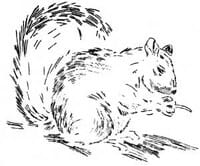 |
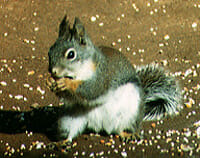 |
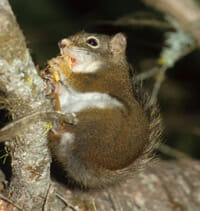 |
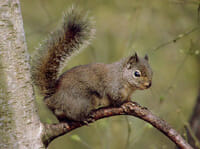 |
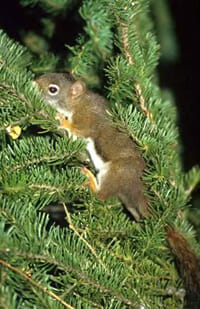 |
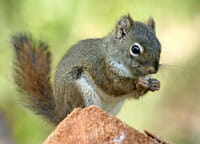 |
Identification & Description:
Like all squirrels, the Douglas Squirrel are mammals who belong to the Order Rodentia. One characteristic which they all share is they have orange front teeth which constantly grow and must be worn down by chewing.
Two common species of Squirrels live in the Pacific Northwest. The Douglas Squirrel differs from its close cousin, the Red Squirrel, because it grows ears tufts in the winter, has a orangish buff belly in the summer (where the red squirrel has white) and has an orangish line of fur between the fur on its back and the fur on its belly. Its overall color tends to be more olive brown than reddish as well. Its tail hairs are tipped with yellow. Their range includes the southwest coast of British Columbia (west of the peaks of the Cascade Mountains) and south to northern California. This species is not found on Vancouver Island. Various subspecies of T. hudsonicus lives in the rest of BC and southwards.
The Douglas Squirrel acts as a guard to other forest creatures by sounding a harsh churring warning when predators, including humans, enter the area. They nest in old holes in trees, such as those made by Pileated Woodpeckers and will only seldom nest in the tops of conifer trees in ball nests made of sticks as Red Squirrels do. Nests are lined with shredded Cedar bark and moss.
Douglas squirrels tend to eat seeds from Douglas Fir, Sitka Spruce, Shore Pine and other cones by peeling off each scale, discarding the scale and removing the seed. The discarded scales pile up over time and create what is called a “midden”. Sometimes generations of squirrels use these same eating areas and a midden may be over a meter high and several meters in diameter. They are sure signs that a squirrel lives nearby.
They will also harvest green cones and nuts (such as beaked hazelnut) and hide them in mid to late summer in preparation for winter. These they hide in nooks and crannies in the forest to eat later. Many cones are forgotten and some seeds germinate. This is how some trees get their start in the forest. Listen for the sound of the cones hitting the roof of your house and watch as they hide their cones. Sometimes, these hiding places are raided by crows and jays who watch the squirrels at work.
Other food eaten by squirrels include mushrooms, which are dried first. These you may see hanging from a crotch of a tree. Maple seeds, eggs and nestling birds, young of small mammals such as mice, invertebrates, flowers, fruit and other nuts will be eaten as well.
A Douglas Squirrel is active almost year ’round, with the exception of during very cold spells. During these they simply curl up in a warm tree cavity and sleep, much like their cousins from colder climates. Once the temperature warms up again, they are active, running and chirping their warnings.
Courtship includes chases around the base of trees that may be fast, frantic and noisy. Watch for this behaviour about late March. Four kits are usually born in April. These mature quickly and within about 3 months are on their own. Sometimes they will have a second litter because of the longer season. A lone Douglas Squirrel occupies a territory of about 1 hectare (2 to 3 acres) and will defend their territory using calls and chasing other squirrels out of their territory. The tables are turned when the offending squirrel goes back into his own territory and he will chase the follower back into its own area. The only time they will share territories is during mating season and when females raise their young.
In the Greater Vancouver, Seattle and other areas, the population of Douglas Squirrels has been impacted by introductions of larger non-native Grey Squirrels. Grey squirrels are very aggressive and much larger and will scare Douglas squirrels from their territory where they over lap. This leaves the Douglas squirrel vulnerable to predators, cats, being run over by cars etc. Grey Squirrels tend to prefer deciduous forests though, where as Douglas prefer conifer forests.
Behaviour
Douglas squirrels are very active during the day. They run in the trees and on the ground. When the weather is bad, they will stay in their nests. Douglas squirrels build summer nests of moss, lichen and pieces of bark and twigs. In the winter they make their nests in holes in trees. Douglas squirrels are very territorial and very vocal.
Life Cycle
Mating season for the Douglas squirrel happens between late February and April. A little over a month after mating, the female gives birth to between four and six babies. The babies are born with their eyes closed and are hairless. Their hair will grow in a little over two weeks and their eyes will open in about a month. They are weaned after eight weeks. The young squirrels may stay with their mother for most of their first year.
Diet
The Douglas squirrel eats pine seeds. In the fall, it cuts green pine cones from tree limbs and buries them in special piles called middens. The Douglas squirrel also eat acorns, berries, mushrooms and fruits.